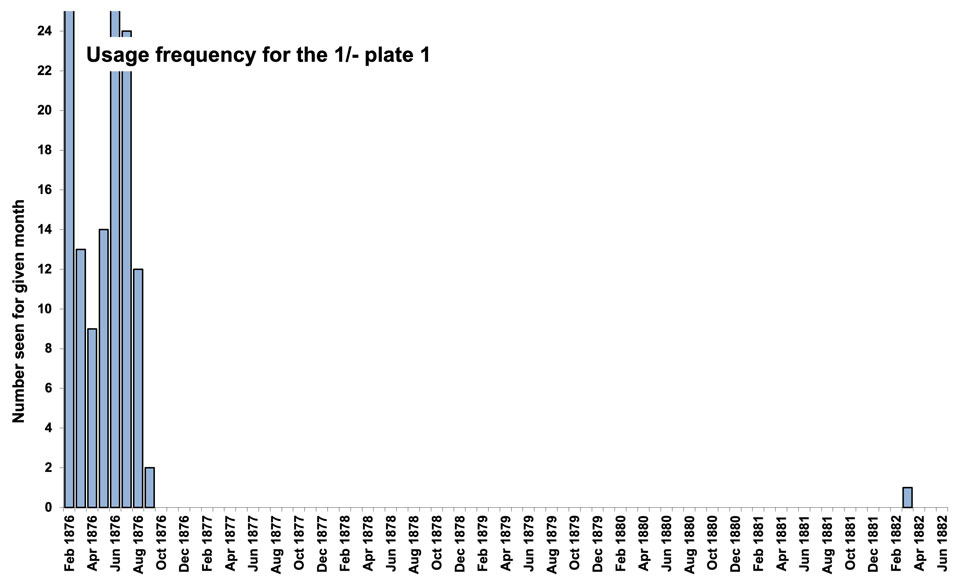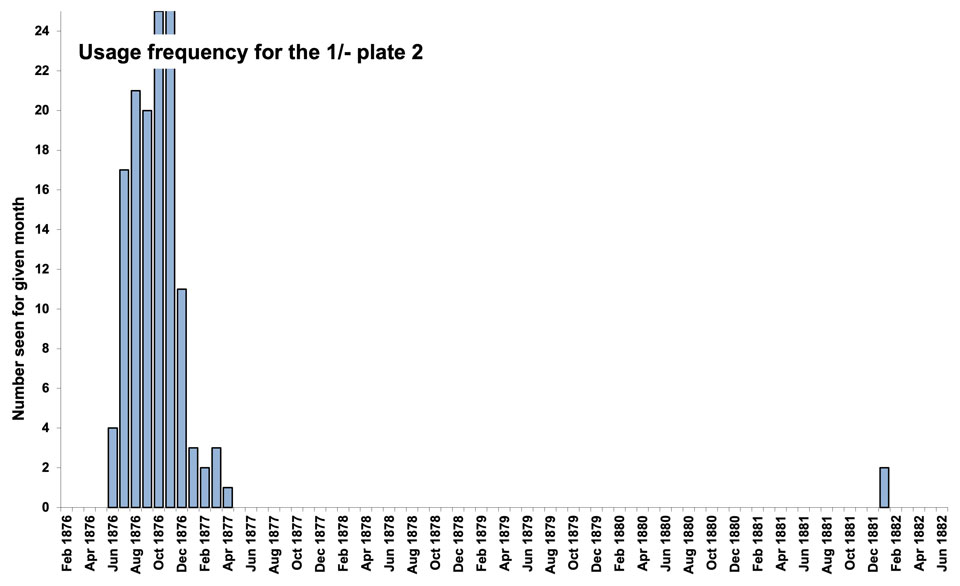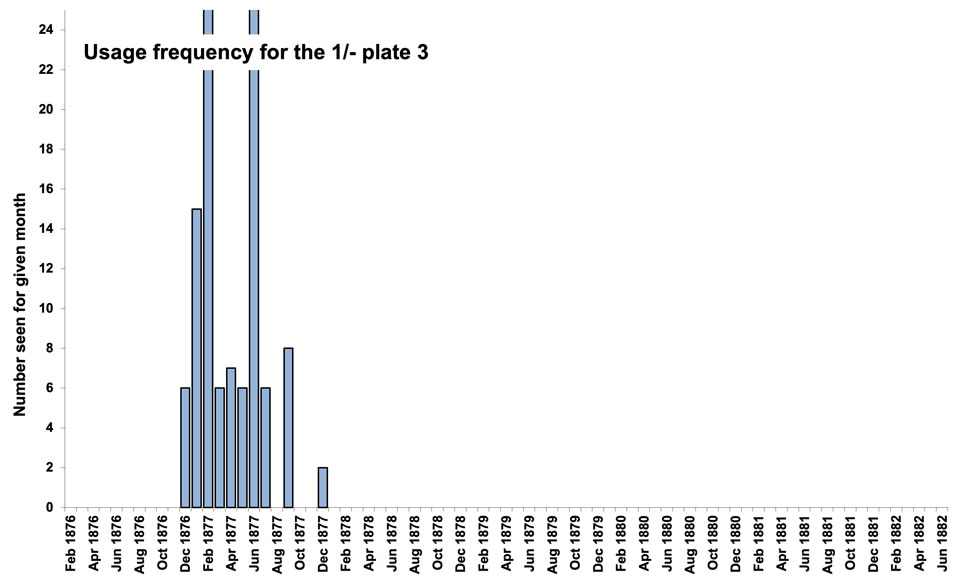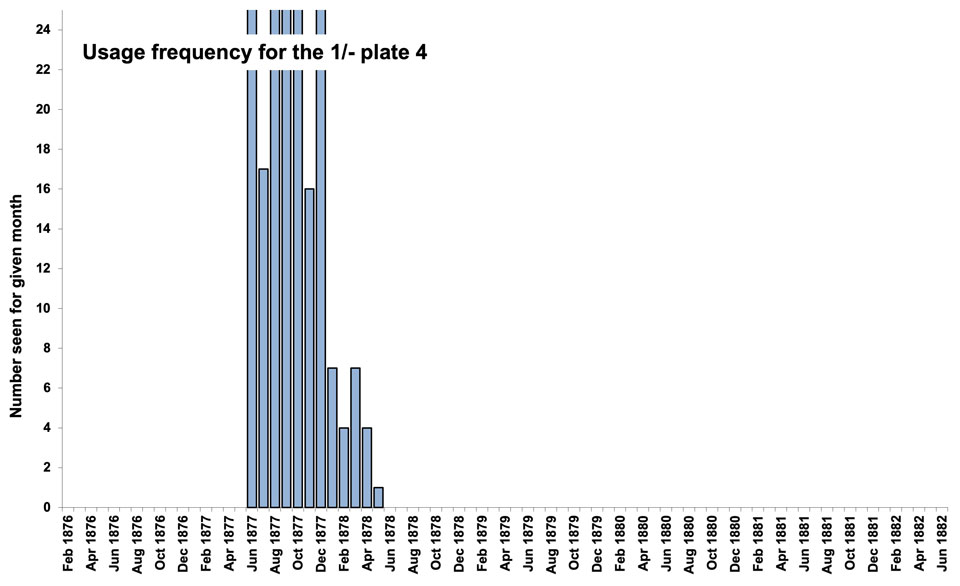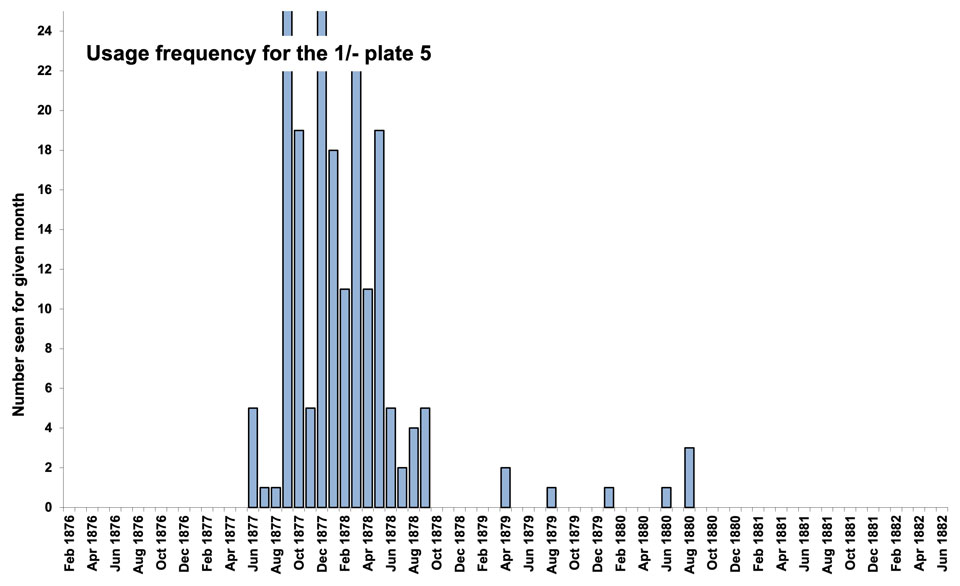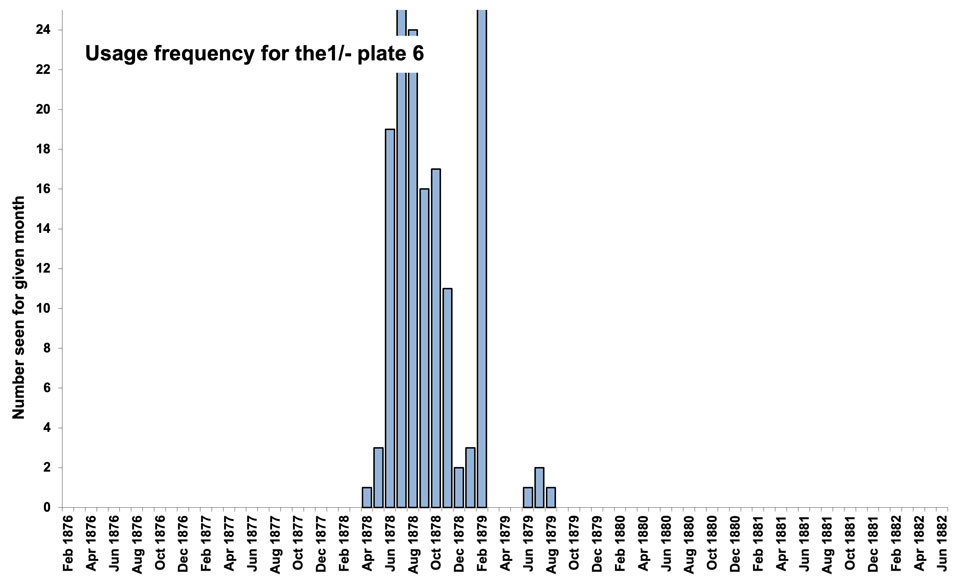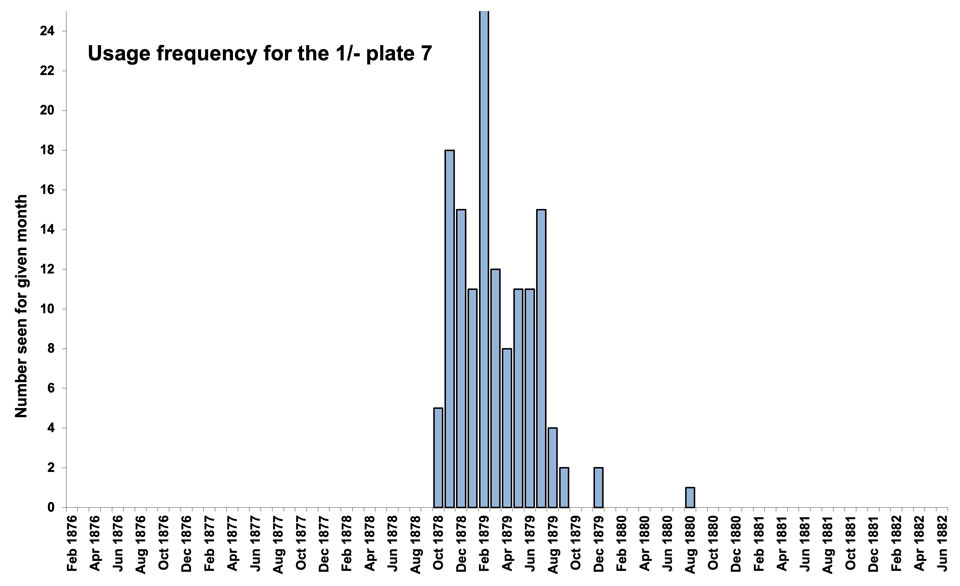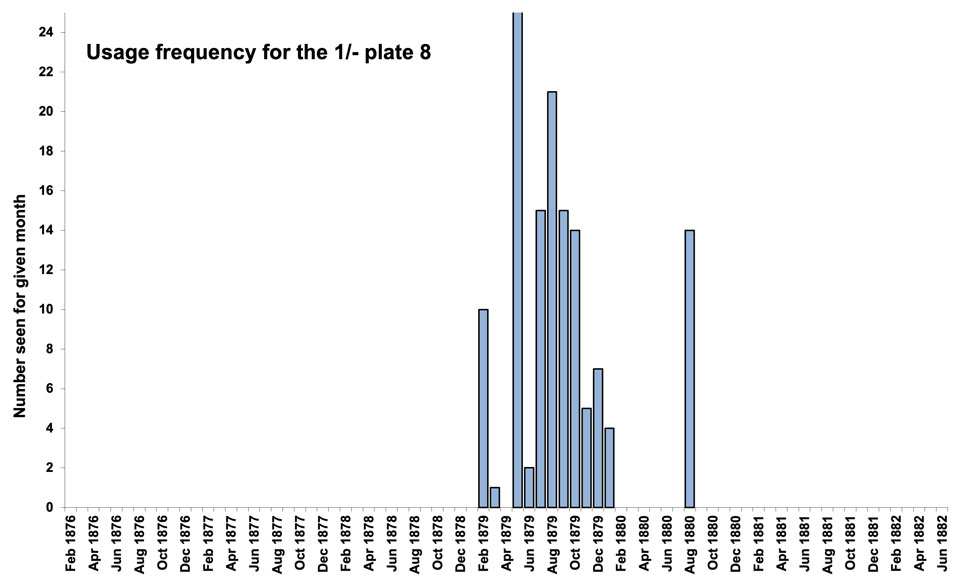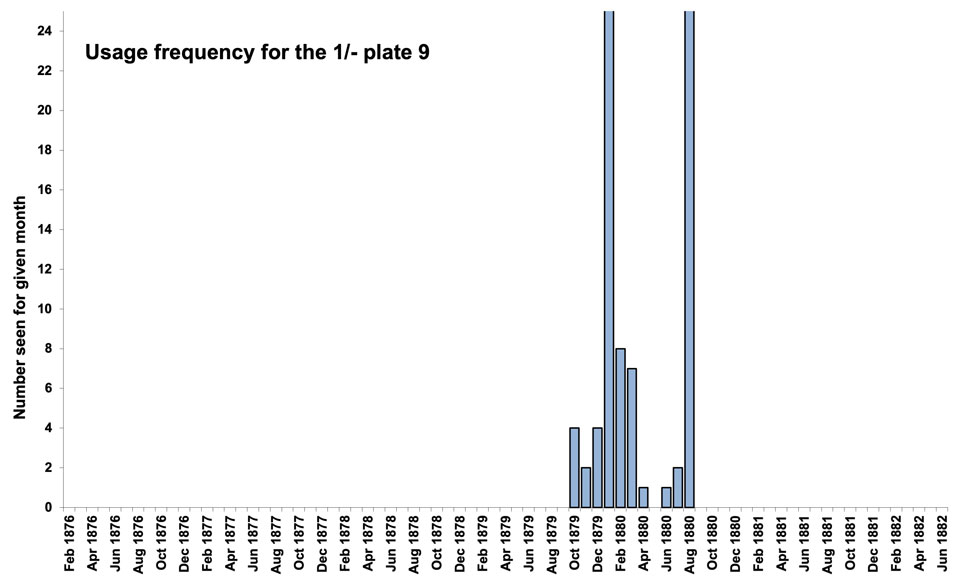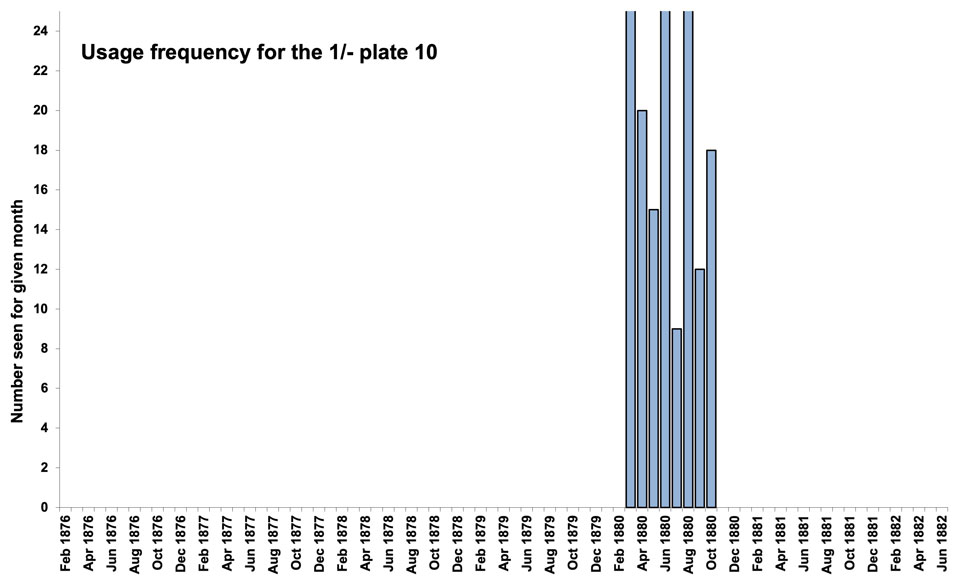1 Essays
2 Die Proofs
3 Sheet Layout
4 Plate Proofs
5 Paper
6 Imprimaturs
7 Colour Standards
8 Specimens
9 Issued Stamps

Date: 1 Feb 1876
Plates: 1-12
Printer: De La Rue
Watermark: Spray (sideways)
Perforation: 14
The 1s Telegraphs was issued on 1 Feb 1876 together with 1d, 3d, and 5s values. However, no example of any telegraph stamp has been found dated earlier than 4 Feb 1876.
It had been decided that telegraph stamps of the same value as postage stamps would be printed in the same colour and on the same paper as the corresponding postage stamps, hence this stamp was printed in green on Spray of Rose paper.
The basic rate for an inland telegram was 1s, so it’s not surprising that there were more 1s stamps printed than any other value, and consequently there are more plates, imprimaturs, etc, than for any other value.
Twelve plates were prepared and registered, imprimaturs exist from all twelve printed in green. The colour of the stamp was changed to brown-orange part way through the print run of plate 10. Only the registration sheets were printed from plates 11 and 12 in green.
Essays




These four essays were submitted shortly after the passing of the “Telegraph Act, 1868”, dating them 1868-69.
| — | 1s | — | — | silhouette in black |
| — | 1s | — | — | silhouette in green |
| — | 1s | — | — | wreath in black |
| — | 1s | — | — | wreath in green |




An essay using a line-engraved ½d was submitted by Mr. T. Boucher on 20 Feb 1875 (reconstruction). Three essays for the 1s value were prepared by De La Rue for the first issue: Series A and Series B essays dated “24 MAR 75”, and the approved design submitted on 31 Mar 1875.
| — | 1s | — | NL | line-engraved ½d |
| A | 1s | 55 | AB | blue-green |
| B | 1s | 55 | AB | deep green |
| C | 1s | 55 | AB | green, approved design |
For more details on first issue essays click here.


Several examples of the first design above have been seen by us; however, it is not an essay but a cut-out from an Australian telegraph form (Electric Telegraph, Queensland, c.1880). The second is from a set of 12 black & white essays which are undated but believed to be circa 1880. Their purpose is not known, but they are likely not related to the issued stamps.
| — | 1s | — | — | brown |
| — | 1s | — | — | black & white |
For more details on additional essays click here.
Die Proofs
Die proofs are printed in black on white glazed card, typically 92 x 60mm, unless otherwise noted. They are listed below ordered by date, with undated proofs following those with the same plate number. The rightmost column gives the number recorded in our database: in private hands + institutionalised.

To see more 1s Die Proofs click here.
| 1 | June 25, 1875 | — | — | — | 1 |
| 2 | June 30, 1875 | — | — | — | 1 |
| 3 | July 1, 1875 | — | — | — | 1 |
| 4 | July 2, 1875 | — | — | — | 1 |
| 5 | July 3, 1875 | — | — | — | 1 |
| 6 | July 4, 1875 | — | — | — | 1 |
| 7 | July 6, 1875 | — | — | “BEFORE HARDENING” | 5 + 2 |
| 8 | no date | — | — | Basic Die Proof | 0 + 1 |
| 9 | July 14, 1875 | 1 | BB | “AFTER HARDENING” | 1 + 1 |
| 10 | July 14, 1875 | 1 | RA | “After Striking 15 Leads” (“JPS”)* | 1* |
| 11 | Aug 4, 1875 | 2 | LA | “After Striking 15 Leads” | 1 |
| 12 | Aug 12, 1875 | 3 | TL | “BEFORE STRIKING” (“TR”)* | 1* |
| 13 | Aug 12, 1875 | 3 | FD | “AFTER STRIKING 81 Leads”, “JPS” | 1 |
| 14 | July 25, 1876 | 4 | AB | “BEFORE STRIKING” (“FJ”)* | 2* |
| 15 | July 25, 1876 | 4 | MA | “After Striking 13 Leads”, “FJ” | 1 |
| 16 | Mar 16, 1877 | 5 | — | “After Striking”, “HH” | 2 |
| 17 | no date | 5 | — | “WG” | 2 |
| 18 | Aug 17, 1877 | 6 | — | “BEFORE STRIKING” | 1 |
| 19 | Aug 28, 1877 | 6 | — | “AFTER STRIKING” | 2 |
| 20 | Apr 2, 1878 | 7 | JB | “After Striking 59 Leads”, “SNE” | 1† |
| 21 | Apr 6, 1878 | 7 | — | “AFTER STRIKING”, “SNE” in blue | 1 |
| 22 | July 26, 1878 | 8 | — | “Before Striking”, “CPK” | 2 |
| 23 | July 27, 1878 | 8 | CB | “After 25 Leads”, “CPK” | 1 |
| 24 | Aug 14, 1879 | 10 | — | “WG” in pencil, “JUT”(?) in ink | 1 |
| 25 | Apr 13, 1880 | 11 | — | “After Striking”, “UGN” | 1 |
| 26 | no date | 11 | NC | “After Striking 50 Leads”, “WG” | 0 + 1 |
| 27 | no date | 12 | — | “UGN” | 2 |
* Recorded with and without initials, likely the same one.
† Vertical format.
Institutionalised/Total: 5/40.
From the Striking Books
Die proofs were cut down to stamp size and pasted into De La Rue’s record books, then annotated with the date and the number of leads stuck from the die. The books were cut up and sold in the 1970s.
At some point, both Plate 1 and Plate 2 proofs were roughly torn, removing the dates from the right-hand side. It’s unclear why anyone would have done this. We show before and after images of each above (torn images in the second column), and list both states in the table below.
| July 16, 1875 | — | — | “240 Leads … “ | 1 |
| July 16, 1875* | 1† | — | “July 16 / 240 Leads”, “ly 29 75” | 0 + 1‡ |
| “ | “ | “ | above roughly torn | “ |
| Aug 10, 1875* | 2 | AA | “Aug 10 / 240 Leads”, “Aug 30” | 1 |
| “ | “ | “ | above roughly torn | “ |
| Aug 16, 1875 | 3 | — | “Aug 16”, “Sep 3 1875” | 1 |
| July 29, 1876 | 4 | — | “July 29 / 240 Leads”, “Sep 12 76” | 0 + 1‡ |
| Mar 15, 1877 | 5 | — | “March 15 / 240 Leads”, “April 9 77” | 0 + 1‡ |
| Aug 28, 1877 | 6 | TA | “Aug 28 / 240 Leads”, “Sep 22 1877” | 1 |
| Apr 6, 1878 | 7 | — | “April 6 / 240 Leads”, “30 78” | 1 |
| July 31, 1878 | 8 | — | “July 31 / No 8 / 240 Leads”, “7 78” | 1 |
| Oct 23, 1878 | 9 | — | “Oct 23 / 240 Leads”, “16 78” | 1 |
| Aug 20, 1879 | 10 | — | “Aug 20 / 240 Leads”, “Sept 79” | 0 + 1‡ |
| Apr 9, 1880 | 11 | — | “April 9 / No 11 / 240 Leads”, “y 13 80” | 1 |
| June 23, 1880 | 12 | — | “June 23 / 240 Leads / No 12”, “ly 16 1880” | 0 + 1‡ |
* Originally dated, but roughly torn removing the date.
† Plate number “1” in manuscript.
‡ Langmead Collection — reconstruction.
In a Countersunk Frame


| no date | — | — | Cut down, set in a countersunk frame | 2 |
Sheet Layout
The sheet had 240 stamps in 12 panes, arranged as three rows of four. Each pane had 20 stamps in four rows of five. To the left of each pane reading upwards was “TELEGRAPHS ONE SHILLING.”. Plate numbers were in the upper left and lower right corners, current numbers in the lower left and upper right corners, all reading upwards. At the middle of each side was a cross used as a perforating guide.
A Post Office sheet was one pane, valued at one pound.

Computer generated image, click to enlarge.
Plate Proofs



Plate proofs are known for plates 2, 3, 4, 8, and 9. Those above for plates 2, 3, and 4 are reconstructions as they are in institutional collections. All are from a corner of a pane and are the only ones known. All are probably unique with no examples available to collectors.


Plate 8 is the most common of the 1s plate proofs. The reconstruction shows there was a block of eight from the right side of the sheet. Two pairs remain intact: SE-TE and SF-TF; TG is illustrated in Wright and Creeke. Plate 9 was likely a block of six, but only three are known.
Red represents an institutionalised example.
Green a known example in private hands.
Blue is unknown but predicted by the pattern.

| Institutionalised/Total: | 1/1 |
| Royal Philatelic Collection: | — |
| British Postal Museum: | — |
| Tapling Collection: | — |
| Langmead Collection: | TL |
| Phillips Collection: | — |

| Institutionalised/Total: | 1/1 |
| Royal Philatelic Collection: | FH |
| British Postal Museum: | — |
| Tapling Collection: | — |
| Langmead Collection: | — |
| Phillips Collection: | — |

| Institutionalised/Total: | 1/1 |
| Royal Philatelic Collection: | — |
| British Postal Museum: | — |
| Tapling Collection: | — |
| Langmead Collection: | TI |
| Phillips Collection: | — |

| Institutionalised/Total: | 3/8 |
| Royal Philatelic Collection: | SE-TE |
| British Postal Museum: | — |
| Tapling Collection: | — |
| Langmead Collection: | TG |
| Phillips Collection: | — |

| Institutionalised/Total: | 2/6 |
| Royal Philatelic Collection: | — |
| British Postal Museum: | — |
| Tapling Collection: | — |
| Langmead Collection: | AA |
| Phillips Collection: | BA |
Paper
The 1s telegraph stamp was printed on the same paper as the corresponding postage stamp. It was printed on Spray of Rose paper.

The watermark as seen from the front of the stamp.
For more details on Spray paper click here.
Imprimaturs




Plates 1 to 4 were registered on 28 July 1875, 30 Aug 1875, 2 Sept 1875, and 11 Sept 1876.




Plates 5 to 8 were registered on 5 Apr 1877, 20 Sept 1877, 30 Apr 1878, and 26 Sept 1878.




Plates 9 to 12 were registered on 15 Nov 1878, 19 Sept 1879, 13 May 1880, and 15 July 1880.
The registration sheets for the Telegraphs have been lost. However, we can reconstruct them from known examples and a clear pattern emerges. Most have a column of 12 taken, plus four from the adjacent column, and a plate number example from the opposite corner. One sheet of each value has an extra column of 12 taken.
Plate 1 strip of five KH-OH in the Langmead Collection was once thought to be from the registration sheet. However, its edges show that it is from the Colour Standard sheet, but missing the SPECIMEN overprint. Plate 8 OH is listed in Langmead and Huggins, but this is an error copied from a Robson Lowe catalogue.
Red represents an institutionalised example.
Green a known example in private hands.
Blue is unknown but predicted by the pattern.

| Institutionalised/Total: | 8/17 |
| Royal Philatelic Collection: | AJ, TL |
| British Postal Museum: | AI, AK |
| Tapling Collection: | PB |
| Langmead Collection: | PK |
| Phillips Collection: | PC, PG |

| Institutionalised/Total: | 8/17 |
| Royal Philatelic Collection: | AA, TL |
| British Postal Museum: | BI, BK |
| Tapling Collection: | AE |
| Langmead Collection: | AL |
| Phillips Collection: | AB, AD |

| Institutionalised/Total: | 8/17 |
| Royal Philatelic Collection: | AA, TL |
| British Postal Museum: | BI, BK |
| Tapling Collection: | AI |
| Langmead Collection: | AL |
| Phillips Collection: | AB, AF |

| Institutionalised/Total: | 8/17 |
| Royal Philatelic Collection: | AA, TL |
| British Postal Museum: | SB, SD |
| Tapling Collection: | TI |
| Langmead Collection: | TA |
| Phillips Collection: | TB, TF |

| Institutionalised/Total: | 8/17 |
| Royal Philatelic Collection: | AA, TL |
| British Postal Museum: | SB, SD |
| Tapling Collection: | TD |
| Langmead Collection: | TA |
| Phillips Collection: | TC, TH |

| Institutionalised/Total: | 8/17 |
| Royal Philatelic Collection: | AA, TL |
| British Postal Museum: | SE, SD |
| Tapling Collection: | TD |
| Langmead Collection: | TA |
| Phillips Collection: | TB, TF |

| Institutionalised/Total: | 8/17 |
| Royal Philatelic Collection: | AA, TL |
| British Postal Museum: | BI, BK |
| Tapling Collection: | AH |
| Langmead Collection: | AL |
| Phillips Collection: | AB, AC |

| Institutionalised/Total: | 8/17 |
| Royal Philatelic Collection: | AA, TL |
| British Postal Museum: | SI, SK |
| Tapling Collection: | TF |
| Langmead Collection: | TA |
| Phillips Collection: | TB, TC |

| Institutionalised/Total: | 8/17 |
| Royal Philatelic Collection: | AA, TL |
| British Postal Museum: | BI, BK |
| Tapling Collection: | AH |
| Langmead Collection: | AL |
| Phillips Collection: | AC, AE |

| Institutionalised/Total: | 8/17 |
| Royal Philatelic Collection: | AA, TL |
| British Postal Museum: | SB, SD |
| Tapling Collection: | TF |
| Langmead Collection: | TA |
| Phillips Collection: | TB, TI |

| Institutionalised/Total: | 8/17 |
| Royal Philatelic Collection: | AA, TL |
| British Postal Museum: | SI, SK |
| Tapling Collection: | TG |
| Langmead Collection: | TA |
| Phillips Collection: | TB, TD |

| Institutionalised/Total: | 8/17 |
| Royal Philatelic Collection: | AA, TL |
| British Postal Museum: | BB, CA |
| Tapling Collection: | AI |
| Langmead Collection: | AL |
| Phillips Collection: | AC, AF |
Colour Standards


Two complete sheets came on to the market in the 1930s: plate 1, imperforate, overprinted Specimen Type 10 horizontally, and plate 4, imperforate, overprinted Specimen Type 9. The latter after a slight change to the ink recipe so it is a little paler.
Red represents an institutionalised example.
Green a known example in private hands.

Plate 1: Pane PA-TD was recently split.
Pane PI-TL is in the Langmead Collection.

Plate 4: Half pane PK-TL was recently split.
Pane KI-OL is in the Langmead Collection.
Plate 1 strip of five KH-OH in the Langmead Collection was once thought to be from the registration sheet. However, its edges show that it is from the Colour Standard sheet, but missing the SPECIMEN overprint.
Click the images to enlarge.
Specimens
Plate 1 Type 8: not known but may exist as there are similar 1d & 3d.




Plate 1 Type 10: scarce, from 3 panes (AA-ED x2, KA-OD), all singles.
Plate 2 Type 9: rare, from 1 pane (AA-ED), only 6 known.
Plate 3 Type 9: scarce, from 3 panes (PA-TD x3), two blocks of 4 known.
Plate 4 Type 9: rare, from 1 pane (FI-JL), all singles.




Plate 5 Type 9c: rare, from 1 pane (AA-ED), only 3 known.
Plate 6 Type 9c: scarce, from 5 panes (AE-EH x2, KE-OH x3), one block known.
Plate 7 Type unknown (12×2 mm): no gum, of questionable status.
Plate 8 Type 9b: scarce, from 5 panes (FA-JD x4, KI-OL), one pair and a block known.
Click the images to enlarge.
Reference to scarcity, blocks and the number of sheets or panes so treated is derived from reconstructions of known examples within our database.
Issued Stamps
Stamps were issued from plates 1 to 10. Plates 11 and 12 were registered but not put to press in green.
The usage frequency graphs show how quickly the 1s plates were used up, each plate following the previous with a few months of overlap.
Click the graphs to enlarge.

For postal, fiscal, and railway usage click here.
Issued Stamps — Plate 1
Plate 1 (current no. 478) was registered on 28 July 1875 and approved on 9 Aug 1875. It was put to press on 28 July 1875 and taken from press on 22 Feb 1876 after printing 35,000 sheets.
Scarcity #11 in mint telegraphs, #21 in used telegraphs.


Mint multiples in our database include a block of six, three blocks of four, and several pairs including two plate number pieces.
Used multiples are scarce. Two pairs, three blocks of six, and a complete pane of 20 are in our database. The earliest known used example is 4 Feb 1876 at Ardrossan in Scotland (illustrated).
No inverted watermarks are known to us.
Click the images to enlarge.
Issued Stamps — Plate 2
Plate 2 (current no. 485) was registered on 30 Aug 1875 and approved on 23 Sept 1875. It was put to press on 22 Feb 1876 and taken from press on 25 Sept 1876 after printing 35,000 sheets.
Scarcity #20 in mint telegraphs, #25 in used telegraphs.


Mint multiples are scarce. Two blocks of four are known to us.
Used multiples are scarce. Three blocks of four, a pair, and a strip of three are known to us. The earliest known used example is 20 June 1876 at the London Stock Exchange (illustrated).

Inverted watermarks are rare. One mint example is known to us.
Click the images to enlarge.
Issued Stamps — Plate 3
Plate 3 (current no. 486) was registered on 2 Sept 1875 and approved on 23 Sept 1875. It was put to press on 11 Oct 1876 and taken from press on 1 May 1877 after printing 35,000 sheets.
Scarcity #24 in mint telegraphs, #17 in used telegraphs.


No mint multiples are known to us, not even a pair.
Other than the telegraph form below, used multiples are scarce with a strip of five, three strips of four, three pairs, and a block of four in our database. The earliest known used example is 5 Dec 1876 in Aylsham (illustrated).

Many of the used examples are from Formby, dated 21 or 22 Feb 1877. These were used at the Admiral’s Cup Hare Coursing event. It would be a rare stamp without this leakage.
No inverted watermarks are known to us.
This telegraph form was sent from London to New Zealand in January 1877. The telegram cost a staggering £9-12-8 for just a seven word message. The price was calculated based on ten words in the addresses plus seven words in the message: 17 words at 11/4d each word. Unfortunately, some stamps have been removed and others re-affixed in different positions, although this does not detract from this incredibly rare survivor. The telegram pre-dates the second issue and clearly shows the need for high values.
Click the images to enlarge.
Issued Stamps — Plate 4
Plate 4 (current no. 508) was registered on 11 Sept 1876 and put to press on 1 May 1877. It was taken from press on 23 Aug 1877 after printing 35,000 sheets.
Scarcity #26 in mint telegraphs, #2 in used telegraphs.


Mint multiples are rare with one pair known to us.
Used stamps are common (plates 4 and 5 coincided with the large leakages in June, Sept, and Dec 1877). Used multiples are common with 52 pairs, five strips of three, two strips of four, 26 blocks of four, three blocks of six, and blocks of seven and 10 in our database. The earliest known used example is 12 June 1877 in Glasgow (illustrated).

Inverted watermarks are rare. Only two used singles are known to us.
Occasionally stamps are found still on part of the original telegraph forms. The forms are usually trimmed close to the stamps but whoever was liberating them in Shepton Mallet left larger parts of the forms intact. Several singles and pairs of plates 4 and 5 are in our database in this manner from this office.
Click the images to enlarge.
Issued Stamps — Plate 5
Plate 5 (current no. 532) was registered on 5 Apr 1877 and put to press on 23 Aug 1877. It was taken from press on 1 Mar 1878 after printing 35,000 sheets.
Scarcity #21 in mint telegraphs, #3 in used telegraphs.


No mint multiples are known to us. A badly creased block of eight (NA-OD) was recently split into singles, although a pair may still remain.
Used stamps are common (plates 4 and 5 coincided with the large leakages in June, Sept, and Dec 1877). Used multiples are common with 61 pairs, five strips of three, a strip of four, 31 blocks of four, a block of five, six blocks of six, a block of nine, and a perfin block of 16 in our database. The earliest known used is 25 Sept 1877 with dozens of examples on this date.


Inverted watermarks are rare. Only one mint and five used singles are known to us.
Click the images to enlarge.
Issued Stamps — Plate 6
Plate 6 (current no. 542) was registered on 20 Sept 1877 and put to press on 1 Mar 1878. It was taken from press on 9 Aug 1878 after printing 35,000 sheets.
Scarcity #18 in mint telegraphs, #19 in used telegraphs.


Mint multiples are scarce. One complete pane, a block of eight, and a pair are in our database.
Used multiples are rare with a strip of three and a pair in our database. A strip of four was split to make the pair and two singles. The earliest known used example is 7 May 1878 at Piccadilly Circus B.O. (illustrated).


An imperforate used single, not an imprimatur. Probably unique.
Inverted watermarks are rare. Only two used singles are known to us.
Click the images to enlarge.
Issued Stamps — Plate 7
Plate 7 (current no. 557) was registered on 30 Apr 1878 and put to press on 20 Aug 1878. It was taken from press on 9 Dec 1878 after printing 35,000 sheets.
Scarcity #23 in mint telegraphs, #20 in used telegraphs.


Mint multiples are scarce. One block of eight and a pair are in our database.

Used multiples are scarce with a strip of five, a strip of three, and five pairs in our database. The earliest known used example is 11 Oct 1878 (not seen by us).

Inverted watermarks are rare. Two used singles are known to us from a pair which was split.
Click the image to enlarge.
Issued Stamps — Plate 8
Plate 8 (current no. 566) was registered on 26 Sept 1878 and put to press on 9 Dec 1878. It was taken from press on 13 Aug 1879 after printing 35,000 sheets.
Scarcity #3 in mint telegraphs, #26 in used telegraphs.


Mint multiples are common with three complete panes of 20, blocks of 15, 12, and 8, two blocks of 6, five blocks of 4, a strip of 3, and three pairs in our database.
Used multiples are scarce with a complete pane of 20, two blocks of four, a strip of three, and three pairs in our database. The earliest known used example is 12 Feb 1879 at Mark Lane in London (illustrated).

Inverted watermarks are rare. One used single is known to us.
Click the images to enlarge.
Issued Stamps — Plate 9
Plate 9 (current no. 569) was registered on 15 Nov 1878 and put to press on 19 Sept 1879. It was taken from press on 2 Feb 1880 after printing 35,000 sheets.
Scarcity #16 in mint telegraphs, #23 in used telegraphs.

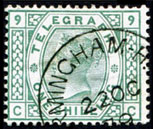
Mint multiples are scarce. One block of four and a block of six are in our database.
Used multiples are rare with only one vertical pair and two blocks of four (originally a block of eight) in our database. One of these blocks of four and a strip of three are in the Langmead Collection. The earliest known used example is 22 Oct 1879 in Birmingham (illustrated).

Inverted watermarks are rare. Only two used singles are known to us.
Click the image to enlarge.
Issued Stamps — Plate 10
Plate 10 (current no. 582) was registered on 19 Sept 1879 and put to press on 2 Feb 1880. The colour was changed to brown-orange after printing about 13,000 sheets in green.
Scarcity #17 in mint telegraphs, #18 in used telegraphs.


Mint multiples are rare with only one block of four in our database.
Another block of four is in the Phillips Collection.
Used multiples are scarce with two blocks of six, a block of four, a strip of three, and four pairs in our database. The earliest known used example is 2 Mar 1880 at Dumbarton (illustrated).
Inverted watermarks are rare. One used single is known but not seen by us.
Click the images to enlarge.
Issued Stamps — Plates 11 & 12
Plates 11 (current no. 589) and 12 (current no. 595) were registered on 13 May 1880 and 15 July 1880. Only the registration sheets were printed in green. Imprimaturs exist, but no perforated examples are known.





















